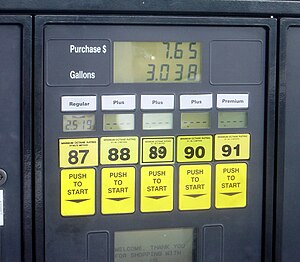
- Image via Wikipedia
Building a Better Biofuel: A New Carbon-Neutral Approach Turns Carbohydrates into Hydrocarbons
When Randy Cortright of the University of Wisconsin found an aromatic fluid floating in his beaker that smelled just like gasoline, he thought he had a problem. After all, the chemical engineer wanted to make fuel from plants for the hydrogen economy that was supposed to boom about now. Instead, when he put the fluid in a chromatograph, he found it had all the hydrocarbon components of a high-octane gasoline.
“We’re making hydrocarbons that look just like the hydrocarbons from fossil fuels,” such as heptane, isooctane and others, Cortright says. And with a barrel of oil costing more than $80 per barrel, making gasoline from the carbohydrates in plants rather than much-touted hydrogen is proving a better business opportunity for Cortright and Virent Energy Systems, the Madison, Wisc.-based company he founded to commercialize the technology.
Just as a typical oil refiner cracks petroleum into a mixture of hydrocarbons ranging from ethane to jet fuel, Virent transforms sugars into a fuel that has a 102 octane rating. “Instead of feeding in crude oil, we’re feeding in sugar water,” Cortright explains. The fuel also delivers roughly 115,000 British thermal units per gallon, close to conventional gasoline’s 125,000. That’s because Virent’s biogasoline does not have oxygen molecules along for the ride, unlike ethanol (the oxygen simply takes up space without adding much in the way of fuel, hence ethanol’s lower energy density). And their new facility has already churned out in trial runs 2,000 liters of the carbon-neutral fuel—deemed as such because the CO2 absorbed from the atmosphere by the plant is the same CO2 released to the atmosphere when the fuel is burned—and started making 2,000 liters more to enable further testing on April 9.
Virent can make a batch of fuel in one hour rather than the days required for fermentation of plant sugars into ethanol or the eons to produce natural petroleum, though it employs the same tricks as nature: heat and pressure. The real key to the process is catalysis, which enables and speeds up the necessary chemical reactions. Or as physicist Steven Koonin, undersecretary of science at the U.S. Department of Energy told the recent ARPA-e conference, “During my time at BP, I came to understand that catalysis is more of a black art than science.”
That’s because much of what happens when a catalyst affects a given chemical reaction is unknown. DOE and others are working to change that but Virent is simply harnessing it. Cortright and chemical engineer James Dumesic discovered in their university lab back in 2001 that by starting with water and various carbohydrates from plants—basically, carbon, hydrogen and oxygen compounds—and using catalysts, heat and pressure, they could start creating CO2 and hydrogen and then use that hydrogen to eliminate the oxygen as water (the process produces more water than it consumes). “If we didn’t make H2 we started making these nonoxygenated hydrocarbons, losing the H2 into methane, ethane and gasoline components,” Cortright explains.
Related articles by Zemanta
- Catalyst Brings Cheap Hydrogen Fuel Closer to Reality (news.sciencemag.org)
- Pressure-cooking algae into a better biofuel (scienceblog.com)









![Reblog this post [with Zemanta]](http://img.zemanta.com/reblog_b.png?x-id=d8710b44-ff47-4cbd-b543-b68012d1743b)
